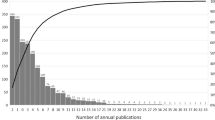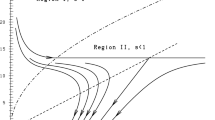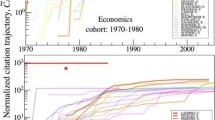Abstract
Scientific productivity is constant as a scientist ages according to recent studies relying mainly on quantity measures of productivity. An economic model of the life-cycle productivity of scientists is presented which implies that the number of citations made to a scientist's previous work will decline with age. The implication could be consistent with the finding of constant quantity output with age if the decline in quality (as measured by number of citations per article) is large enough.
Similar content being viewed by others
Notes and references
H. LEHMAN,Age and Achievement, Oxford University Press, London, 1953, pp. 3–21 and 308–323 (on mathematicians see especially pp. 8 and 311).
F. CAJORI,A History of Mathematics, 2nd ed., the Macmillan Co., New York, 1922.
LEHMAN, pp. 328–329.
W. DENNIS, Age and Achievement: A Critique,Journal of Gerontology, 11 No. 3, (July 1956) 331–333; Age and Productivity among Scientists,Science, 123 (April 27, 1956) 724–725; The Age Decrement in Outstanding Scientific Contributions: Fact or Artifact?,The American Psychologist, 13, (Aug. 1958) 457–460; Creative Productivity between the Ages of 20 and 80 Years,Journal of Gerontology. 21, No. 1, (Jan. 1966) 1–8; N. STERN, Age and Achievement in Mathematics: A Case-Study in the Sociology of Science,Social Studies of Science, 8 (1978) 127–140; H. ZUCKERMAN, Appendix E: Age-Specific Annual Rates of Productivity of Laureates and Matched Sample of Scientists Who Survived to Each Age, inScientific Elite. The Free Press, New York 1977, pp. 301–302; S. COLE, Age and Scientific Performance,American Journal of Sociology. 84 No. 4, (Jan. 1979) 958–977; I originally thought that a third current position, distinct from those ofLehman andCole, wasPrice's version of the ‘contagion’ model (D. de SOLLA PRICE, A General Theory of Bibliometric and Other Cumulative Advantage Processes,Journal of the American Society for Information Science (Sept.–Oct. (1976) 292–306.) I interpretedPrice's model as implying that for those who ‘caught on’ productivity would increase with age (see pp. 303–304 of above). ButPrice claims that I misinterpreted him and that in fact he agrees withCole: “My own feeling is that productivity in quantity and quality are approximately constant with age though of course productivity must rise from zero to its level during the first few years of scholarly activity and towards the end of life there may well be, in some but not all cases, a tendency to make a slight decline.” (letter, June 23, 1980). See also: D. de SOLLA PRICE, The Productivity of Research Scientists, inYearbook of Science and the Future 1975, Encyclopedia Britannica. 1974. An application ofPrice's contagion model that, from the title, would seem to bear on the age/productivity issue is: Y. WEISS, L. LILLARD, Output Variability. Academic Labor Contracts and Waiting Time for Promotion, in R. G. EHRENBERG, Ed.,Research in Labor Economics 5, (1982) 157–188.Weiss andLillard, however, want to insulate their model from any prima facie implications it might have for the issue: “For the purpose of our analysis it isnot necessary to assume that output is measurable. One can think of abstract andunobserved ‘promotion capital’ which is related, but not necessarily identical to the number of published papers. One can maintain the specific distribution implications of the model for time to promotion without necessarily maintaining the specific distributional implications for papers production” (p. 172, italics in original). DespitePrice's concurrence withCole et al., the current consensus about age/productivity profiles is not total. For a sample of 20 past presidents of the American Economic Association,Eagly found that number of articles peaked at 6 per year at age 47 and declined to about 2 per year at age 67 (R. EAGLY, Contemporary Profile of Conventional Economists,History of Political Economy, 6, No. 1, (1974) 88). For a sample of 5079 scientists,Bayer andDutton compare 6 functional forms of the quantity/age relation of find out which one provides the ‘best fit’. Since they require that all the betas be significant for the model that ‘fits best’, they rule out from the start the possibility that productivity is constant with age (in which case, the constant, but none of the betas would be significant). Of the remaining 6 functional forms, they find that a 4th degree polynomial of age (which they call the spurt-obsolescence function) provides the best fit (A. E. BAYER, J. E. DUTTON, Career Age and Research-Professional Activities of Academic Scientists,Journal of Higher Education, 48, No. 3, (May/June, 1977), pp. 259–282).
Noting correctly that “longitudinal data are superior to cross-sectional data in measuring the effects of age on scientific productivity,” (p. 964)Cole uses longitudinal data for a sample of 497 mathematicians who received their Ph. D.'s between 1947 and 1950. For five year periods between 1950 and 1975,Cole finds that mean citations (in 1975) to articles written in each period varied only slightly around one citation per article (p. 695). From this,Cole concludes that quality of output does not decline with age.Cole's method can be criticized on several grounds. Perhaps the most important of these is that in the early periods the sample includes work by low-quality mathematicians who later stop publishing. Since their work diminishes the group mean in the early periods and since the group mean remains constant over all periods, it follows that the mean quality of work for those mathematicians who continue to publish must decline with age.
COLE, p. 959.
Among the major works in the optimal life-cycle investment literature are G. S. BECKER,Human Capital, 2nd ed., Columbia University Press New York, 1975; Y. BEN-PORATH, The Production of Human Capital and the Life Cycle of Earnings,Journal of Political Economy, 75, No. 4, Pt. I (Aug. 1967) 352–365; G. R. GHEZ, G. S. BECKER,The Allocation of Time and Goods over the Life Cycle, Columbia University Press, New York, 1975; J. J. HECKMAN, A Life-Cycle Model of Earnings, Learning, and Consumption,Journal of Political Economy, 84, No. 4, Pt. 2 (Aug. 1967) S11–S44; H. E. RYDER, F. STAFFORD, P. E. STEPHAN, Labor, Leisure and Training Over the Life Cycle,International Economic Review, 17, No. 3 (Oct. 1976) 651–674; S. ROSEN, A Theory of Life Earnings,Journal of Political Economy, 84, No. 4, Pt. 2 (Aug. 1976) S45–S67; and A. S. BLINDER, Y. WEISS, Human Capital and Labor Supply: A Synthesis,Journal of Political Economy, 84, No. 3 (June 1976) 449–472.
Weiss andLillard treat publications as “promotion capital” although their model puts more emphasis on stochastic contagion processes than does the typical optimization-under-constraints human capital model. (See Y. WEISS, L. LILLARD, Output Variability, Academic Labor Contracts and Waiting Time for Promotion, in: R. G. EHRENBERG, Ed.,Research in Labor Economics, 5, (1982) 157–188).
G. S. BECKER,Human Capital, esp. pp. 63–67.
One of the most articulate recent defenses of the power of the economic model of man is: G. J. STIGLER, G. S. BECKER, De Gustibus Non Est Disputandum,American Economic Review 67 (March 1977) 76–90.
For examples see: A. SMITH,The Theory of Moral Sentiments, Oxford University Press Oxford 1976, p. 126; and an unnamed biochemist quoted in: W. O. HAGSTROM,The Scientific Community, Basic Books, New York, Inc. 1965, p. 125.
Author information
Authors and Affiliations
Rights and permissions
About this article
Cite this article
Diamond, A.M. An economic model of the life-cycle research productivity of scientists. Scientometrics 6, 189–196 (1984). https://doi.org/10.1007/BF02016762
Received:
Issue Date:
DOI: https://doi.org/10.1007/BF02016762




